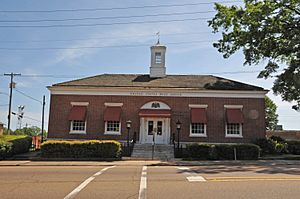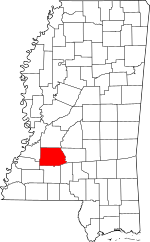Copiah County, Mississippi facts for kids
Quick facts for kids
Copiah County
|
|
|---|---|

|
|

Location within the U.S. state of Mississippi
|
|
 Mississippi's location within the U.S. |
|
| Country | |
| State | |
| Founded | 1823 |
| Seat | Hazlehurst |
| Largest city | Crystal Springs |
| Area | |
| • Total | 779 sq mi (2,020 km2) |
| • Land | 777 sq mi (2,010 km2) |
| • Water | 2.2 sq mi (6 km2) 0.36% |
| Population
(2020)
|
|
| • Total | 28,368 |
| • Density | 36.416/sq mi (14.060/km2) |
| Time zone | UTC−6 (Central) |
| • Summer (DST) | UTC−5 (CDT) |
| Congressional district | 2nd |
Copiah County is a county found in the state of Mississippi. In 2020, about 28,368 people lived there. The main town, or county seat, is Hazlehurst.
The Pearl River forms the eastern edge of Copiah County. The county is also part of the larger Jackson, Mississippi area.
Contents
History of Copiah County
Copiah County was created in 1823. It was the 18th county in Mississippi. Its name comes from a Choctaw Indian word meaning calling panther. At that time, Walter Leake was the governor of Mississippi, and James Monroe was the President of the United States. In 2004, a lake called Calling Panther Lake was opened to remember this special name.
Early Settlements and Towns
The Choctaw Indians gave up their land claims in 1819. Soon after, in 1823, Copiah County was formed. A Methodist minister named Elisha Lott moved his family to the area. They settled near what is now Crystal Springs.
In 1858, the New Orleans, Jackson and Great Northern Railroad built tracks through the area. A new town grew up about a mile and a half west of the old settlement. This new town became known as Crystal Springs. The older settlement was then called Old Crystal Springs.
William J. Willing built the first home in the new Crystal Springs. Jefferson Davis, who was president of the Confederacy, once gave a speech from his front yard. The first store was owned by Ozious Osborne.
Farming and Growth
In the 1800s, cotton farming became very important in Copiah County. This type of farming shaped the county's population before the Civil War.
The first church in Hazlehurst was built by Methodists in 1860. Baptists built their church in 1861, and Presbyterians in 1870. Trinity Episcopal Church was built in 1882. After the American Civil War, many formerly enslaved people started their own churches.
Copiah County also became known for growing vegetables to sell. This was called "truck farming." Crystal Springs grew into a major center for shipping tomatoes. Commercial farming began in 1870 when James Sturgis shipped the first peaches to New Orleans and Chicago.
Tomatoes were once called "love apples." N. Piazza brought tomato seeds from Italy and, with S. H. Stackhouse, started growing them scientifically. A German immigrant named Augustus Lotterhos helped the tomato industry become very successful. In 1878, Lotterhos gathered tomatoes from many growers and sent the first boxcar full to Denver, Colorado.
Civil Rights Era
In the 1960s, Hazlehurst and Crystal Springs were important places for the Civil Rights Movement. People worked with the Mississippi Freedom Democratic Party in 1964. They helped people register to vote and learn about their rights.
They also organized to make changes after new federal laws were passed in 1964 and 1965. Groups like the Deacons for Defense and Justice helped protect protesters. These protesters worked with the NAACP to boycott stores in 1966 and 1967. They wanted public places to be open to everyone and for civil rights laws to be followed. The Deacons for Defense first formed in Natchez in 1965 to protect African-American protesters.
Geography of Copiah County
Copiah County covers about 779 square miles. Most of this area, about 777 square miles, is land. Only a small part, about 2.2 square miles, is water.
Main Roads and Highways
 Interstate 55
Interstate 55 U.S. Highway 51
U.S. Highway 51 Mississippi Highway 18
Mississippi Highway 18 Mississippi Highway 27
Mississippi Highway 27 Mississippi Highway 28
Mississippi Highway 28 Mississippi Highway 844
Mississippi Highway 844
Neighboring Counties
- Hinds County (north)
- Simpson County (east)
- Lawrence County (southeast)
- Lincoln County (south)
- Jefferson County (southwest)
- Claiborne County (west)
Protected Natural Areas
- Homochitto National Forest (part of it is in Copiah County)
Population of Copiah County
Copiah County is mostly rural. It has seen its population decrease at certain times. This happened during the Great Migration, when many African Americans moved from the rural South. From 1910 to 1920, many moved North to cities like St. Louis or Chicago. From 1940 to 1970, many moved West, especially to California, for new jobs.
| Historical population | |||
|---|---|---|---|
| Census | Pop. | %± | |
| 1830 | 7,001 | — | |
| 1840 | 8,954 | 27.9% | |
| 1850 | 11,794 | 31.7% | |
| 1860 | 15,398 | 30.6% | |
| 1870 | 20,608 | 33.8% | |
| 1880 | 27,552 | 33.7% | |
| 1890 | 30,233 | 9.7% | |
| 1900 | 34,395 | 13.8% | |
| 1910 | 35,914 | 4.4% | |
| 1920 | 28,672 | −20.2% | |
| 1930 | 31,614 | 10.3% | |
| 1940 | 33,974 | 7.5% | |
| 1950 | 30,493 | −10.2% | |
| 1960 | 27,051 | −11.3% | |
| 1970 | 24,749 | −8.5% | |
| 1980 | 26,503 | 7.1% | |
| 1990 | 27,592 | 4.1% | |
| 2000 | 28,757 | 4.2% | |
| 2010 | 29,449 | 2.4% | |
| 2020 | 28,368 | −3.7% | |
| 2023 (est.) | 27,664 | −6.1% | |
| U.S. Decennial Census 1790–1960 1900–1990 1990–2000 2010–2013 |
|||
| Race | Number | Percent |
|---|---|---|
| White (not Hispanic) | 12,171 | 42.9% |
| Black or African American (not Hispanic) | 14,264 | 50.28% |
| Native American | 17 | 0.06% |
| Asian | 121 | 0.43% |
| Pacific Islander | 24 | 0.08% |
| Other/Mixed | 660 | 2.33% |
| Hispanic or Latino | 1,111 | 3.92% |
In 2020, there were 28,368 people living in the county. There were 9,414 households and 6,609 families.
Tomato Festival Fun
Copiah County is famous for growing tomatoes and cabbages. For many years, Crystal Springs was even called the "Tomato Capital of the World." This was because in the late 1930s, it canned and shipped more tomatoes by train than any other place.
In June 2000, the town brought back its annual Tomato Festival. It happens on the last Saturday in June. The festival has a tomato growing contest with prizes for the biggest, ugliest, and prettiest tomatoes. There's also tomato tasting, a farmers' market, and booths from different sellers. You can enjoy musical entertainment, a 5K run, and the crowning of the new Tomato Queen.
The night before the festival, there's a Street Dance to kick things off. This is when the Tomato Queen is crowned. You can listen to a live band, play games, and enjoy amusement rides. Food sellers are also there. The Junior Auxiliary of Crystal Springs sells "BBQ and Blue Jeans" take-out meals. This is also when other festival sellers start setting up their booths. People come from all over the U.S. to sell their goods and provide fun activities. There's even a tomato museum at the Chautauqua Park Visitor Center. It shows old pictures, farming tools, and examples of shipping and canning labels.
Education in Copiah County
Copiah County has two public school districts:
- Copiah County School District
- Hazlehurst City School District
There is also a private school called Copiah Academy.
For college, students in the county can attend either Copiah–Lincoln Community College or Hinds Community College.
Communities in Copiah County
Cities
- Crystal Springs
- Hazlehurst (the county seat)
Towns
- Georgetown
- Wesson (partly in Lincoln County)
Village
Unincorporated Communities
These are smaller communities that are not officially towns or cities:
Ghost Town
- Coars Springs (a town that no longer exists)
See also
 In Spanish: Condado de Copiah para niños
In Spanish: Condado de Copiah para niños

